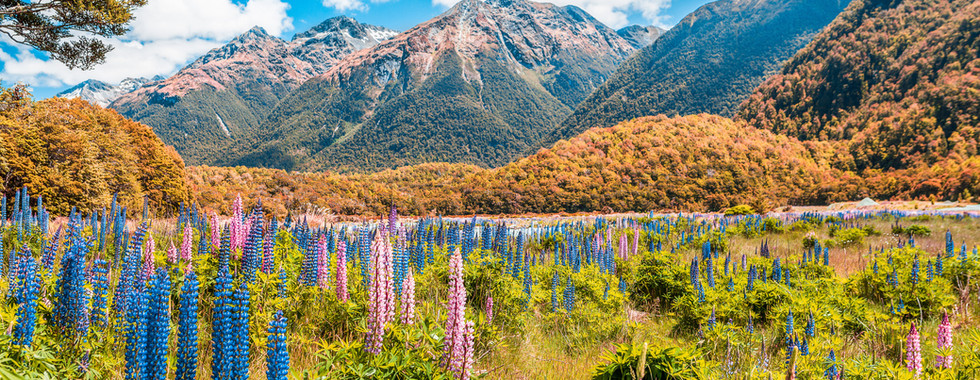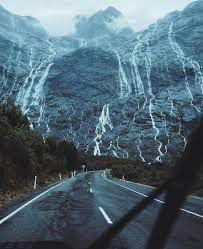Skip Forward
A fair enough question to ask and a question that gets us so excited to answer because we love talking about all the great things of Milford Sound. For starters the creation of Milford Sound has taken place over a few million years. It is a UNESCO World Heritage Site. A marine sanctuary, endangered and rare wildlife is in abundance in these parts compared to the rest of New Zealand. The only way to describe the waterfalls in the fjord is - wow! Finally, it is one of the most visited places in New Zealand. In this article we will explain why.
Milford Sound
Before getting into all of the reasons Milford Sound is so special, it's a good time to quickly run through a few facts. Milford Sound is not actually a sound (which is a river valley flooded by the sea), it is a fjord (a glacial valley flooded by the sea). It's name originates from the first explorer - John Grono, who named it after a narrow inlet in Wales called Milford Sound in 1823. The fjord is 16km long, less than 3km at its widest point and its deepest point is 291 metres. About 900,000 visitors travel to Milford Sound each year,, with Australia, United States, United Kingdom, Germany and China among the highest visiting countries. Milford Sound is surrounded by steep, near vertical mountains that are covered in lush native forest. This creates a perfect habitat for all sorts of wildlife such as birds, Kiwi, insects and deer. Milford Sound is marine reserve and the fjord itself is full of all sorts of fish, coral, dolphins, seals and is often frequented by sharks or whales.
Milford Sound is popular because of its rare natural beauty that is barely touched by modern civilisation. There are very few buildings in the township and strict rules from the New Zealand government and Department of Conservation mean that any development at all must meet the environments best interests. Milford Sound is captivating, exciting, relaxing, calming all in one, and also has an element of adventure in it. The drive into Milford is equally as beautiful and this builds the tension as you approach the world famous fjord. It is must do on your bucket list, it can be explored so many ways, on a budget or in comfort, by road or plane, by boat or kayak and at anytime of the year.
UNESCO World Heritage Site

Milford Sound is part of the Te Wahipounamu World Heritage Site. This site covers 2.6 million hectares of New Zealand's south west corner and extends 40-90km inland from the Tasman Sea. Milford Sound, along with the rest of Fiordland was admitted into UNESCO due to its glacial carving, rock & land formations, peaks, plants and animals which were around 80 million years ago when New Zealand was part of Gondwana, the ancient super continent. It is considered one of the finest glaciated areas in the Southern Hemisphere.
Glacial carving
It is sometimes hard to understand glacial carving but Milford Sound and some of the areas before Milford Sound make it very obvious as to what it leaves behind. Over the last 2-million years, massive rivers of ice a few kilometres wide have flowed down from the Southern Alps, creating narrow, steep valleys out of the mountains on their way to the Tasman Sea. As the earth warmed out of the ice ages, the glaciers melted, leaving behind these valleys and allowing the sea to flood through to create what we now see as Milford Sound.
Milford Sound Waterfalls
There is very few places in New Zealand and the world where you can get just centimetres from the full force of massive, tall 160 metre waterfalls, unless you are on a cruise in Milford Sound. Lady Bowen Falls at 162 metres and Stirling Falls at 151 metres, are permanent waterfalls in Milford Sound. The first actually powers Milford Sound through a hydroelectric system. These waterfalls are fed by

mountain lakes and rivers that were also part of the glacial carving events in history. Although these waterfalls are spectacular in their own right, where Milford Sound really comes to life from a waterfall perspective is when it rains. Milford Sound is one of the wettest places in the world, receiving almost 7,000mm (275 inches) of rainfall each year. Within minutes of rain hitting the mountains above, hundreds of waterfalls start appearing throughout the fjord. It is a sight to behold and is the reason a lot of Fiordland locals will tell you that their favourite time in Milford Sound is when it is pouring with rain.
Mountains & Mitre Peak

The familiar sight you will see as you arrive into Milford Sound by tour is Mitre Peak, standing at 1,683 metres. Familiar because it is one of the most recognisable images seen in relation to not only Milford Sound, but also New Zealand. Almost 100% of visitors would have a photo of themselves with Mitre Peak in the background. The mountain, with a narrow & challenging track that goes to the top, is a beautiful sight to behold and as your cruise tracks underneath it, you will feel as tiny as you ever have.
Down the fjord however is a few more iconic mountains to witness - The Elephant (1,517 metres) and The Lion (1,302 metres), as they are fondly known for their resemblance to the associated animals. Before viewing Stirling Falls, you may also get a glimpse at Mount Pembroke in the distance, standing at 2,015 metres. Although these heights sound dizzying, some of the other mountains in the close by areas, particularly to the north can reach up to 4,000 metres, a lot of which carry snow on their peaks for the entire year.
Milford Sound Wildlife
Visitors are always astounded at how close and how many encounters you can get during a cruise through Milford Sound. It is not uncommon to see one type of wildlife, while another introduces itself from a different direction. You are all but 100% guaranteed to see New Zealand Fur Seals at Seal Point, near the entrance to Milford Sound by the Tasman Sea. Most cruises will take you up close to witness these cute, playful creatures basking in the sun. Another likely encounter is with the famous 'Kea', the world's only mountain parrot and native to only the South Island of New Zealand. These cheeky and naughty birds are found in the alpine parts of mountain ranges, which you will experience along the Milford Road prior to the Homer Tunnel. On our Luxe Tour for example, we tend to have several encounters with the Kea each day. They will jump up on vehicles and are known to peck at, and even start stealing parts off of vehicles.
Less frequent but very popular is the Bottlenose Dolphin, of which a pod of about 50 call the Milford Sound area home. Bottlenose Dolphin's are one of the larger dolphins found in the world, growing up to 3-metres in length, but interestingly those found in Milford Sound can even get up to 4-metres, down to the abundance of food in the area. Often most visitors to Milford Sound may have only seen dolphins in a zoo or aquatic park setting, rarely in their natural environment. It is a beautiful and exciting encounter that will create a connection to nature like no other.
There is a lot of other wildlife to be seen, such as the elusive Fiordland Crested Penguin, Blue Ducks, Albatross, and many other fish and bird species, but the Seals, Dolphins and Kea are ones you are most likely to see on any given day.
The Milford Road
Although Milford Sound is your ultimate destination, the journey is just as good. Starting from Te Anau, the Milford Road is 120km in length and takes 2-hours to drive non-stop, however generally takes most about 4 to 5-hours due to the number of worthwhile photo stops and experiences. These include Te Anau Downs, the Eglinton Valley, Mirror Lakes, Knobs Flat, Lake Gunn, The Divide, Hollyford Valley, Lake Marion Track, Homer Tunnel and The Chasm. All need a camera with plenty of storage space, but also the ability to switch off from technology and simply enjoy the sounds and sights. Birdsong can often be heard, or the rushing of water. Depending on the weather you may be able to see wildlife off in the distance such as Kea birds.
The Milford Road is a very narrow, winding piece of road however and it is for this reason that it is recommended to take a tour. Many visitors will drive themselves into Milford Sound and more times than not they will comment or review online with regret that they didn't take a tour so they could enjoy the sights more and not have to focus on the road. The road should be respected from a safety point of view and if self driving, please take care out there.
Other activities
There are many other activities that can be undertaken in Milford Sound other than a cruise, such as kayaking, scenic helicopter flights, short walks, scuba diving, and larger hikes (not for the faint hearted). These can be added into the day alongside your tour or cruise and really add to the experience. Imagine kayaking through Milford Sound and on the off chance a dolphin appears beside you!

Several scenic flight companies operate out of Milford Sound airport through the day and it may amaze you to learn that Milford Sound airport is actually the busiest controlled airspace in New Zealand! While few do take a flight, they are enjoyed by all who get up above the mountains and see the beautiful glacial carving from height, as well as even a few glaciers themselves. We highly recommend Milford Helicopters or Southern Lakes if you are looking to spend some time in the air. They can connect back to Te Anau or Queenstown. Luxe Tours has a helicopter add on option as part of our Milford Sound Day Tour.
Special for a reason
Apart from the iconic photo of Mitre Peak, some may wonder why Milford Sound is so popular and considered the unofficial 8th wonder of the world. Is it really that special? Is it really worth visiting? The answer is simply yes. We are of course slightly biased as this is our backyard, but having travelled the world, there are few places that match Milford Sound in terms of the overall experience of geology, history, wildlife and of course beauty. These factors combined make it a must see destination. Behind Mitre Peak lies another 13 kilometres of completely untouched beauty that is ripe for exploring. A place to relax and disconnect from the real world, technology and the hustle & bustle of cities. A place to learn about important geological history, connect with the environment and understand why protecting it is so critically important. Milford Sound is a place to indulge in nature!














![T2025 Sustainability logo compressed[89]_edited.png](https://static.wixstatic.com/media/7929c2_efa3e07eafe243e2bcb24b056c0c7696~mv2.png/v1/fill/w_149,h_150,al_c,q_85,usm_0.66_1.00_0.01,enc_auto/T2025%20Sustainability%20logo%20compressed%5B89%5D_edited.png)


